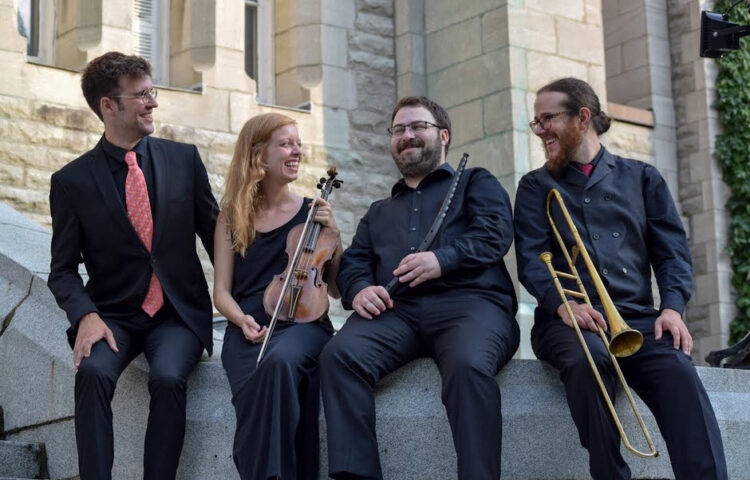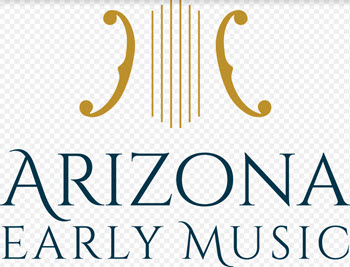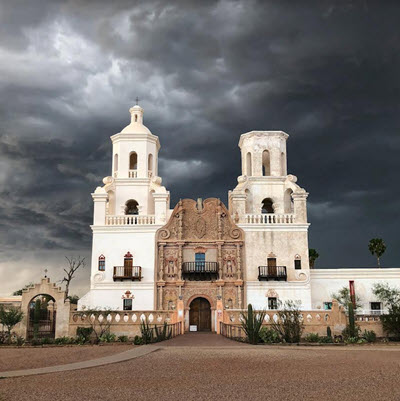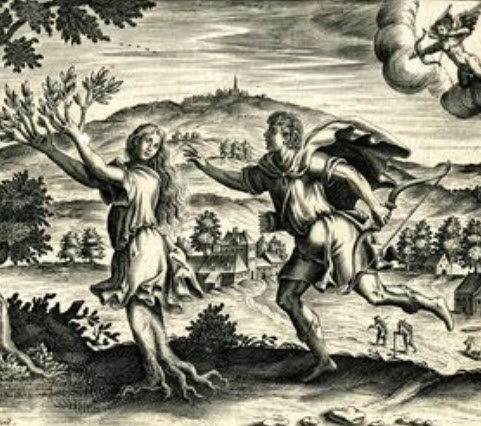by Anne E. Johnson
Published August 5, 2024
Arizona Early Music’s Emerging Ensemble Residency. Nine days. Fully funded. For an ensemble ‘to come out and really just spend time together.’
Residency performances start August 14 at a national landmark, the San Xavier del Bac Mission in Tucson

After more than four decades as a concert presenter in and around Tucson, Arizona Early Music (AEM) is expanding its role in the historical performance world. This August, the society will host its first Emerging Ensemble Residency (EER), inviting a young group to work on both the performance and business aspects of the industry.
The EER was an idea pitched by Dominic Giardino, who in 2021 became AEM’s executive director, its first professional administrator. He describes the venture as “a major departure from our regular programming.”
The motivating factor, he explains, was an urge to help, “to encourage the next generation.” So AEM founded “a residency exclusively for ensembles working in early music under a certain age threshold who really haven’t had the opportunity to perform on main stages across the country and globe.”
Why ensembles? It makes sense for AEM’s mission as a presenting organization, Giardino explains. “It’s not often that we hire an individual and build a band around them. We’re always looking at touring ensembles.”
For the inaugural year, the residency was granted to Montreal’s Le Consort laurentien (LCL), named in honor of the St. Lawrence River. Its members — Baroque violinist Julie Rivest, cornetist Étienne Asselin, sackbut and trombone player Maximilien Brisson, and keyboardist Christophe Gauthier — formed about six years ago, but COVID arrested their progress just as they were getting started.
Although the foursome has had recent success at competitions in Utrecht and York, Brisson says this Arizona residency represents a turning point for the ensemble. “This was perfect timing — time to think and reflect on the future and the plans we have and continue to build the ensemble sound and, also, a chance to pre-rehearse some material for our first season.”
He’s referring to LCL’s inaugural concert season at Montreal’s Notre-Dame-de-Bon-Secours, “a beautiful little church in the Old Port. It’s all wooden, and it has a lovely acoustic for early music. It happens also that the best chest organ [a small positive organ] in town is parked there, which is very convenient.”

Giardino, who is a historical clarinetist (and former EMA board member), says the Arizona residency is meant to be highly practical, noting “how hard it is, one, to pull together an ensemble; two, to find the funds to sustain that ensemble; and then, three, to actually find the time and the space to work together. This residency is a nine-day, fully funded opportunity for a group to come out and really just spend time together.”
That benefit was a selling point for LCL. “Oddly, we started our group officially after we were all separated geographically,” says Brisson. He is eager for the mentoring aspect offered by the residency. “We feel like we need a bit of professional guidance from somebody established” who can “talk to us about artistic matters and also about career management for the ensemble.”
Giardino says Arizona Early Music allowed the chosen ensemble to request a particular mentor. They named Julie Andrijeski, Baroque violinist and co-founder of Quicksilver, among other groups, and a professor at Cleveland’s Case Western Reserve University. Giardino was immediately enthusiastic, and not only because of her skill in playing early music. “Julie also is essentially an arts administrator and arts educator” with experience “not just in being a part of things but also in building them.”
“We do this very specific style of music,” Brisson explains, “mostly early 17th-century chamber music, and there’s not a lot of groups that do that in North America. The main group of course is Quicksilver in the U.S. We’ve had a lot of mentorship from brass players and from my mentor Catherine Motuz and Matt Jennejohn in Montreal. We felt that it would be nice for a change to have the perspective from a string player who does a lot of this repertoire.”
Although she had met two of LCL’s members, Andrijeski wasn’t familiar with the ensemble and calls it “a surprise to learn that they had selected me as their mentor.” And she loved the idea. “It’s going to be an adventure.” She respects AEM as “really great people that are doing a really good thing for up-and-coming groups, so I wanted to support them.”
Brisson hopes the residency can help LCL in “developing a sense of how to put ourselves out there to get to the point where we get invitations for festivals and series.” They wonder, “Is it worth getting an agency involved? What help would that give us, and what part would we still need to do on our own?”
Andrijeski anticipates those questions and more, such as “Do you want a board, or do you want to go at it like a freelancer would?” Other important topics: “How to work together, how to keep the group together. How to speak to presenters, wondering if you want to be taken on by a presenting organization to do all of your work for you to get you on to series, or do you want to do it yourself? What skills do you have in the ensemble that would make you sway one way or the other?”
There are also the practical aspects of being an early musician, she says: “How you deal with getting instruments that you can’t take on the airplane to your gigs. How to talk to people about borrowing or renting instruments.” Communication is an essential skill, including “how to approach the different sorts of people that can help your career, and how to talk to them, make sure that you value them.”
Andrijeski’s performance advice will be just as valuable to LCL. The ensemble’s instrumentation limits them to “chamber music from that relatively short period of time where you can have a cornetto, a trombone, and a violin together,” Brisson says. “There’s not a huge breadth of repertoire. It’s from the very end of the 16th century until 1670 or something.”
“The stylus fantasticus has to be very free and very extreme,” says Brisson. “From inside, it always feels like it’s enough, but it needs to be way over the top for it to be even remotely over the top for the audience.” Sitting in with Quicksilver in their European debut in May 2024, in Regensburg, was eye-opening for Brisson. “I always thought this [technique] must be difficult. I was surprised that it was actually very easy but it also demands a lot of concentration and effort.”
‘The stylus fantasticus has to be very free and very extreme. It needs to be way over the top for it to be even remotely over the top for the audience.’
“Quicksilver is a very special group because we can do that and stay together,” says Andrijeski. “Part of it is because all of us have a background in music pre-17th century. So all of us know a little bit about what came before the 17th century. Even though it’s a form that could go anywhere, there are some things that almost always happen.”
Access to administrative experts is another perk of the residency. “We’re planning some lunches together to actually have conversations with people on both ends of the spectrum,” from performers to those who manage concert series, says Giardino. “It’s a level of access that isn’t usually made available.”

An essential factor in choosing LCL, says Giardino, was AEM’s goal “to invest in ensembles that hopefully have longevity.” Brisson believes that his group’s commitment to the long-term helped gain them the winning nod. “We’ve had discussions, so we know where we want to go. We have already a fairly clear idea for the future of what our objectives are.”
During the residency, LCL will give three concerts. Two are outside of Tucson, offering the added experience of a short tour. “The ‘residency’ here is broadly southern Arizona,” says Giardino. “So, while they’re going to be based in Tucson, the first performance they’ll be doing (on Aug. 11) is going to be in Patagonia (Ariz.), through a partnership with the Santa Cruz Foundation of the Arts in a beautiful little opera house.”
Arizona Early Music’s goal: Invest in ensembles that hopefully have longevity
For a concert on Aug. 14, they will travel to a national landmark called the San Xavier del Bac Mission, which Giardino describes as “a 17th-century Spanish mission that’s perfect in many ways for the repertoire that they play.” The main residency concert, in Tucson, will take place on Aug. 17 at Catalina United Methodist Church.
“We do some run-out concerts throughout the season,” says Giardino of the AEM season, “but the ERR has been a fabulous opportunity to actually take this music on the road to communities we found are really hungry for this type of music.”
The locations in Arizona are an enticement, says Giardino. “It’s so magical and another benefit of this residency.” He admits, “We just have to deal with 110° heat, but that’s fine. Everyplace is air conditioned. And the elevation changes so rapidly in southern Arizona; it’ll be perfectly pleasant in the evening in August down in Patagonia.”
“We’re very much looking forward to going,” says Brisson, “but we’re also slightly dreading the conditions we’ll find, especially for the violinist. Not so much the heat as the dryness. Julie plays an original 17th-century instrument, so that’s something to be careful with. For my instrument it doesn’t matter. But the heat will make us [trombone and cornetto] play higher, whereas it will make the violin play lower, so there’s intonation issues.”
The five-year plan
Temperature aside, the timing of the residency allows AEM to fill a void in classical music performances, Giardino explains. “There’s a huge chunk of our audience who is interested and is full-time in Tucson and wants more cultural access in the summer months when everything shuts down.”
AEM already has the funds to run the residency annually for at least the next three years, with the hope of continuing well beyond that. Applications open for the 2025 residency as soon as this year’s is finished, around Aug. 19. Eligible ensembles must have a maximum of six members, have been active for at least six months, and consist of musicians ages 18-35.
The application was intentionally designed to be a challenge. “People were required to submit a five-year plan for their ensemble, and a mission statement, but also a spoken introduction done on video to get a sense of how different ensemble members work together and what their character might be in that setting.” He says the applicants “represented a pretty full spectrum of what one might expect to find on a series like ours, and geographically too all over the map.”
The first round of judging was done by members of the AEM board. Then a team of “artistic jurors,” early-music performers, did a second round. This year’s artistic jurors were violinist Maria Romero Ramos, singer and composer Jonathan Woody, keyboardist Byron Schenkman, and oboist Debra Nagy.
Both teams of judges agreed on LCL. “In addition to being an ensemble that is able to articulate its professional and organizational goals very clearly,” says Giardino, “it seemed to us a particularly worthy opportunity to invest in a genre within early music that isn’t really widely represented at all in North America.”
“That’s true,” Andrijeski agrees. “They have a little niche that’s good for them.”
“I think it’s important to have a strong sense of what you want to accomplish through the residency,” says Brisson, asked to share advice on how to write a successful application. “Both to demonstrate that it’s worth inviting you, but also because once you do get invited, there’s not really much of a point of going to a residency and then not making the most of it.”
As pleased as AEM is with LCL, Giardino emphasizes that they’re not looking for cookie-cutter copies in the coming years: “We see the Emerging Ensemble Residency as an opportunity for a wide palette of groups, from Le Consort laurentien basically being ready to take the stage to an ensemble just out of school who has been only playing together for six months and can use a little bit more hands-on assistance.”
The important thing is that lots of groups apply, giving AEM a wide choice. So, Giardino hopes EMA readers will share the 2025 Residency link with young ensembles they know.
Anne E. Johnson is a freelance writer based in New York. Her arts journalism has appeared in the New York Times, Classical Voice North America, Chicago On the Aisle, and PS Audio’s Copper Magazine. She teaches music theory and ear training at the Irish Arts Center in Manhattan. For EMA, she recently reviewed satisfying Schumann in a historical performance.




